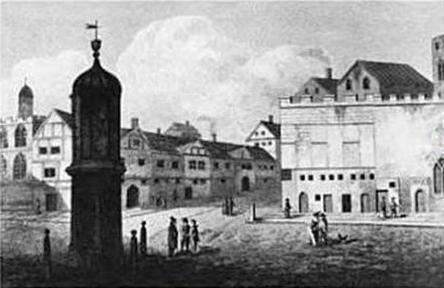A water conduit, and point of measurement. From Wikipedia: "first mechanically pumped public water supply in London, constructed in 1582 on the site of earlier hand-pumped wells and gravity-fed conduits. The mechanism, a force pump driven by a water wheel under the northernmost arch of London Bridge, transferred water from the Thames through lead pipes to four outlets. The service was discontinued in 1603. This became the mark from which many distances to and from London were measured and the name still appears on older mileposts." The 'four outlets' were spouts, one on each face. Removed 1674. Our picture comes from the on-line "Annuls of London" by John Richardson.
This section lists the memorials where the subject on this page is commemorated:
Cornhill Standard
Commemorated ati
Cornhill Standard
At the cross roads the Standard in Cornhill formerly stood. Removed 1674. The...
Sheen milestone
The inscription seems to have been re-carved, incorrectly, at some point, int...
Other Subjects
Albion Tavern
26 Russell Street (previously Great Russel Street). Pubs History lists licencees from 1848 but it dates back to the 18th century at least. Closed by 1922.
Lion Brewery
The (Red) Lion Brewery, designed by Francis Edwards, stood on the South Bank from 1836. The brewery occupied the site now used by the Royal Festival Hall and its stables, warehouses, etc. were on a...
Courage brewery - Horselydown Lane
Founded by John Courage at the Anchor Brewhouse site. The earliest existing building dates from 1871 and was largely rebuilt in 1894 - 1895. Reconstructed, restored and refurbished in 1985 - 1989....
White Horse pub
Pubwiki have a good page on this pub. A tavern has existed here since at least 1690. Known as the White Horse from at least 1745. Rebuilt c.1868-70 and again 1927-8. Closed and was demolished in 20...
Gaston Berlemont
Publican. Born in the Middlesex Hospital. Took over The French House from his Belgian father and ran it until he retired on 1989. The French House is a pub and dining room at 49 Dean Street which d...
Previously viewed
Thomas Chancellor
Co-churchwarden of Mary Abbots Church, Kensington, August 1817. British History Online has some houses in nearby Ansdell Street being built for a 'Thomas Chancellor' which we think might well be o...
William Flockhart
Architect. Born in Kilmarnock. He specialised in designing country houses, including Pasturewood in Surrey, Parkwood in Berkshire and Chelwood Vachery in Sussex.
John Gurney Hoare
Born near Inverforth House, Hampstead. From the banking family. The prime mover in the battle to save Hampstead Heath from development. He was also the prime founder of Christ Church in Hampstead S...










Comments are provided by Facebook, please ensure you are signed in here to see them